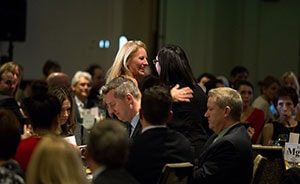The following is a partial transcript of a question-and-answer session, conducted over the FSH Society’s Facebook page, with Julie Hershberg, PT, DPT, NCS. Hershberg is a physical therapist who is a Board Certified Neurologic Specialist. She practices at [re+active] physical therapy & wellness and is an instructor in Doctor of Physical Therapy program at USC.
How can we know when we are overexerting ourselves? I cannot “feel the burn” until it’s too late. Is this a normal response to exercise among FSHD patients? To preface my query: I have FSH muscular dystrophy but am what I call a “middle grounder” in the sense that I am not “normal” in appearance or walking, but don’t yet require super heavy-duty artillery (i.e., full leg braces or chair) to move around. In my youth, I was a dancer and quite an active outdoors person (hiking, swimming, bungee, hang gliding, cycling). But as I have lost my abilities to move around, I also seem to have lost my sense of when too much is too much. My brain still thinks of my “old normative lifestyle,” and my body just can’t do it anymore. What cues do I need to pay attention to when working out so I do not overtax the affected muscles?
This is such a great question, and I think a common one for those with neuromuscular disorders. I have seen this commonly in my clinical practice as well—though it is not a universal problem for everyone with FSHD. I think this is especially hard for the very active person like yourself—we are so used to just pushing through for the ultimate goal instead of necessarily listening to our bodies (I am the same way).
I think all of us as we age need to generally improve our ability to be attuned to our bodies. Everyone experiences fatigue differently, so I cannot give a very specific way for you to read your body. But I generally recommend people to set goals based on time and check-in. For example, swimming for 10-20 minutes and resting for one to two minutes and doing a check-in with your body to see what you are feeling.
If the attunement part is difficult, I highly recommend some of the mindfulness practices to help. The Body Scan is a great way to work on awareness of the body. There is a short Body Scan meditation practice available through UCLA (and many others): http://marc.ucla.edu/body.cfm?id=22.
I don’t recommend doing the Body Scan as you exercise, but doing it separately can help with overall attunement to and awareness of the body. Finally, I recommend having someone—a friend, trainer, PT—watch how you are exercising. There may be some ways you are moving that are not efficient and may set you up for more fatigue or injury, and they could provide you with recommendations to improve the way you move.
Sometimes, especially in my arms, I feel a “ping” like a guitar string breaking. Is this the striae of a muscle? Is it dying? What does it mean?
Well—this is an interesting question! Thank you for asking it! However, without seeing you, this one is tough to know exactly what you may be experiencing in your arms. I have heard people describe “pings” to me in various circumstances that can be muscular twinges or tightness, nerve “tightness,” or even joint related. A physical therapist evaluation would help to determine the cause.
In general, the muscle degeneration that occurs with FSHD does not occur with muscle fibers “dying” instantaneously, so my guess is that this in particular is not a sensation of a dying muscle fiber specifically.
What the research shows is that muscle biopsies from people with FSHD show nonspecific myopathic changes, including rounding of muscle fibers, degenerating and regenerating fibers, increased internal nuclei, and, later in the disease course, increased fibrosis. I am not sure what these muscle fiber changes “feel” like to the person, but I often hear people say that they feel “tight” or “restricted” sometimes. Other people more predominantly notice the atrophy involved.
As far as the striae—the striations of muscle tissue are made by the repetitions of sarcomeres (made of the individual filaments of the muscles). These give the muscle the striated or striped appearance.


Leave a Reply